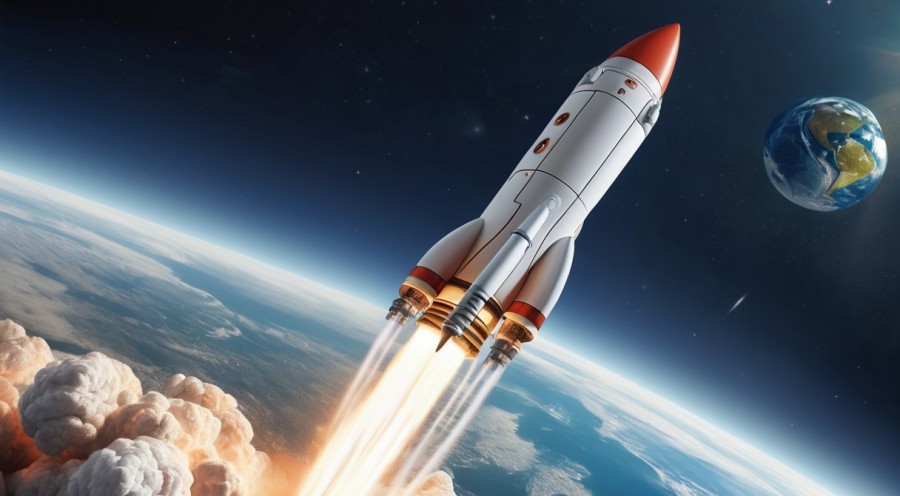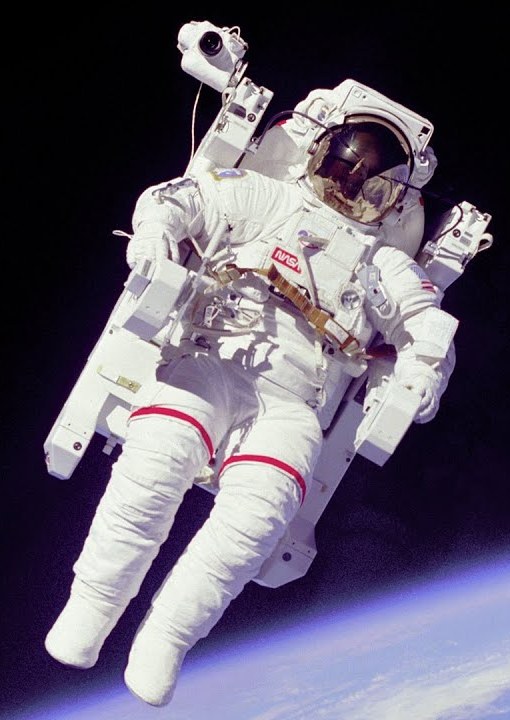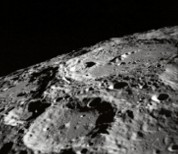
Think about the following questions.
1. Would you like to travel to space? What would you do while you were there?
2. Do you think sending people to the Moon again should be a priority? Why or why not?
3. Why do you think governments spend so much money exploring space?
VOCABULARY PREVIEW
Match each New Academic Word List(NAWL) word with the correct definition.
- shuttle
- fabric _____
- quantum _____
- optical _____
- missile _____
- contradiction _____
- a. woven or knitted material
- b. relating to light or the ability to see
- c. a difference or disagreement between two things which means both cannot be true
- d. a vehicle that travels back and forth between places
- e. the smallest amount of energy that can be measured
- f. a flying weapon that can travel a long distance before exploding at the place at which it is aimed
WHY GO INTO SPACE?

Why do humans feel the need to explore space? The reasons are various, from the abstract1 to the military, from the scientific to the economic. Often, these motives sit in direct contradiction to each other, and while exploring space has obvious benefits, it also carries great risks.
A major historic reason for space exploration has been national pride. Governments like those of the US and USSR used achievements in space to display power. They also suggested that children would be inspired, and humankind would gain a 10 new sense of its own potential. Certainly, the 1969 Apollo Moon landing captured the imagination, but it has not been repeated since 1972. When asked in 2019, only one-third of US citizens believed it was a priority to send humans to the Moon again. However, when asked if the US should maintain its role as a leader in space, seventy-two percent said that it should. Why? First, space is an important arena for national security. Satellite systems give early warning of incoming2 missiles and ensure the accuracy of outgoing3 attacks. On top of this, satellites intercept4 emails and phone or radio communications from suspected criminals and terrorists.
On the other hand, for some citizens, the ability to go to war and monitor private communications may not count as a benefit. And, while the Outer Space Treaty of 1967 makes it illegal to put weapons into space, the UN is concerned that it may be out-of-date and that the accumulation of space weapons in the future is highly likely. Another drawback of space exploration is its cost. In total, the US government has spent $650 billion on NASA projects. Opponents argue that this is money that could have been spent helping people out of poverty, fighting climate change, and addressing other problems on our home planet.
Supporters of space exploration respond that space science has brought us extremely valuable knowledge that benefits humankind. We now have a deeper scientific understanding of quantum physics, the solar system, and the Sun. Researchers have learned about solar wind and solar flares5. These phenomena, known as space weather, can have direct effects on human life as they interfere with satellites and can even cause power cuts on Earth. From space, we can also monitor and understand the weather on our own planet. Further, satellites also allow us to use the Global Positioning System (GPS) and safely navigate around the world. This all leaves us better placed to ensure the safety of the Earth's population. Space research has led to many other technological breakthroughs6 that help humans every day. Without it, we would not have artificial arms and legs, optical lenses that cannot be scratched, heat-resistant fabric for firefighters' suits, shock absorbers for buildings at risk from earthquakes, tablets that clean water, CT scans that find diseases, freeze-dried food, or even the computer mouse.
Not all advancements from space exploration are accidental by-products7, though. In-Space Manufacturing (ISM) involves making or growing things in the space environment, including metals, medicines, and even human organs. The lack of gravity makes mixing elements easier, and working in a vacuum8 ensures the materials are incredibly pure. Still, ISM requires a human crew, and the dangers of manned missions remain high. The Challenger and Columbia space shuttle disasters, which killed seven US astronauts each in 1986 and 2003, made many question whether sending humans into space was worth it. Eventually, it led to the end of the space shuttle program. Today, much space science is done remotely by robots; this lacks the drama of watching astronauts blast off, but at least the public knows it won't end in tragedy.
The results of exploring space are varied and complex. Some are positive and concrete, like life-saving inventions. Others are frightening but hard to measure, like the threat of a weapons buildup9 in space. This important debate will likely continue indefinitely among scientists, policy-makers, and the public.
New Academic Word List
- abstract 1 : adj. existing as an idea, feeling, or quality, not as a material object
- incoming 2 : adj. arriving at or coming toward a place
- outgoing 3 : adj. leaving a place
- intercept 4 : v. to stop something as it goes to a particular place
- solar flare 5 : n. a sudden temporary outburst of energy from a small area of the Sun's surface
- breakthrough 6 : n. an important discovery that helps to improve a situation or provide an answer to a problem
- by-product 7 : n. something that is unexpectedly produced while making or doing something else
- vacuum 8 : n. a space from which almost all matter (solids, liquids, gases) has been removed
- buildup 9 : n. an increase in something that occurs as time passes
READING COMPREHENSION
A ‣ Mark each statement as true (T) or false (F) according to the reading.
- Humans haven't visited the Moon since the 1970s.
- True
- False
- Space weapons have been legal since the 1960s.
- True
- False
- Space research could help us solve climate change, according to supporters.
- True
- False
- Space weather can make it difficult to use electronic devices on Earth.
- True
- False
- Robots carry out most ISM work.
- True
- False
B ‣ Choose the best answer according to the reading.
- What is the main idea of the reading?
- a. Countries must go into space to ensure their national security.
- b. The strongest motivation to explore space is technological advancement.
- c. Space exploration has probably accomplished all that it can.
- d. There are persuasive reasons both for and against going into space.
- Which is NOT true according to paragraph 2?
- a. Space travel was a source of patriotism during the 20th century.
- b. Most Americans think it's important to go back to the Moon.
- c. A presence in space can give countries a military advantage.
- d. Satellites can be useful in preventing crime and terrorism.
- What can be inferred about the UN from paragraph 3?
- a. It strongly opposed the 1967 Outer Space Treaty.
- b. It most likely prefers NASA to lead space exploration.
- c. It probably supports an updated space treaty.
- d. It hopes to control any future weapons in space.
- The word they in paragraph 4 refers to _____.
- a. phenomena
- b. effects
- c. researchers
- d. satellites
C ‣ Look for the answers in the reading and write them on the lines.
- Name two space-research breakthroughs that protect humans from danger or disease.
_____ - What are the benefits of ISM?
_____
SUMMARY
Fill in the blanks with the phrases in the box.
- useful by-products
- sterile environment
- motivate nations
- navigate safely
- accidental and intended
- national pride
There are a number of factors that 1 _____ to explore space. During the Cold War, both the US and USSR used advances in space as a way to boost 2 _____. Having a presence in space is also seen as crucial to ensuring national security. Space exploration has also brought both 3 _____ benefits to humankind more generally. Satellites constantly monitor the weather on Earth and allow us to 4 _____ using GPS. Space research led to the creation of 5 _____, such as artificial limbs and freeze-dried food. More recently, researchers have developed In-Space Manufacturing to create things humans need in a(n) 6 _____.
VOCABULARY PRACTICE
Fill in the blanks with the words in the box. Change the form if necessary.
- contradiction
- fabric
- optical
- quantum
- missile
- shuttle
- The hotel _____ takes guests to the airport every fifteen minutes.
- The study of how tiny particles behave is called _____ mechanics.
- When Jen said she hated junk food but enjoyed hamburgers, Lisa pointed out that it was a(n) _____ .
- The fighter jet fired five _____ at the bridge in order to destroy it.
- Cotton is one of the most popular _____ for clothes because it is inexpensive, washable, and comfortable.
- Dr. Harris is an expert on _____ health; he often tells people that it is important not to look at computer screens for too long.
SUPPLEMENTAL READING
Cassini-Huygens: Working Together

Although space exploration has the ability to divide nations, some missions have the opposite effect: they bring people from all over the world together.
One such mission was the Cassini-Huygens project, on which twenty-eight countries worked together to design and build a robotic spacecraft capable of traveling to Saturn. Cassini, the main spacecraft, was built by NASA in the USA, while Huygens—a smaller "passenger" on Cassini-was built by the European Space Agency (ESA).
One of the main objectives of the mission was to investigate Saturn's mysterious rings. However, scientists also wanted to find out whether Saturn-or one of its eighty-two moons-could support life. So, in 1997, Cassini-Huygens was launched from Cape Canaveral, USA, and began its seven-year journey to Saturn.
In July 2004, the spacecraft entered Saturn's orbit and began sending data and images back to Earth. Later that year, Saturn's moon, Titan, passed close to the planet. and Huygens's moment had come. It left Cassini and began a two-and-a-half-hour descent to the surface of Titan. With parachutes to soften its landing, it found solid ground and sent 350 images of the moon's surface back to Earth via Cassini.
Back on Earth, over 260 scientists from seventeen different countries waited to receive the images, as well as data from the mission as a whole. They found that Saturn's rings are made of ice and rock and are quite new, having been formed while dinosaurs were still living on Earth. They were also surprised to find an ocean and rivers of water on Saturn; these may even support life.
The mission was so successful that it was extended until, after a twenty-year mission, Cassini was destroyed in 2017 while entering Saturn's atmosphere. It leaves behind a more detailed knowledge of our solar system and a reminder of what can be achieved when nations work together.
Fill in the blanks with information from the reading.
- The _____ Cassini-Huygens was the result of collaboration between many nations.
- Cassini-Huygens entered Saturn's _____ seven years after it launched.
- Huygens used _____ to slowly descend to the surface of Titan.

Leave a comment
Load more